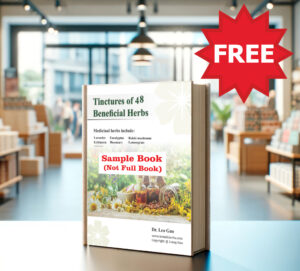Description
Why I Wrote This Book?
The inspiration for writing this book came to me two years ago when I delved into videos discussing tinctures and their benefits. It became evident that many people are deeply interested in understanding how tinctures work and how to create them. As a scientist and engineer, I naturally questioned the validity of these claims. This led me to embark on a journey of researching the benefits of alcohol extraction of herbs, resulting in the exploration of over 500 pieces of literature.
In ancient times, herbs were consumed directly due to the simplicity of their use. I recall my mother preparing herbal medicine by boiling herbs in water, a process that required considerable time for simmering before the medicine was ready. The evolution to water extraction represented a significant advancement from direct consumption, as it enhanced the bioavailability of the medicine for our bodies.
During my Ph.D. studies, I became familiar with using solvents to extract chemicals from various materials. This technology is commonly used in Modern Chinese Traditional Medicine study. Among the solvents mentioned in the 500 literatures I reviewed are alcohol, methane, hexane, chloroform, benzene, and others. Alcohol, particularly, stood out as the most eco-friendly organic solvent, especially for home use, due to its affordability, low toxicity, and excellent extraction properties. This unique characteristic of alcohol makes it ideal for creating herbal extracts, known as tinctures.
Vodka, with a 40% alcohol concentration in the USA, is commonly used for making tinctures due to its widespread availability and relatively low cost. While vodka can extract both hydrophilic and hydrophobic phytochemicals from herbs, its capacity to extract hydrophobic compounds is somewhat limited compared to pure alcohol. Compromise the limitation of alcohol and water extractions, a technique called double tincture is created, particularly useful for extracting precious herbs like Reishi mushroom. This technique involves first using a high concentration alcohol (e.g., higher than 90% alcohol) to extract hydrophobic compounds, followed by a water extraction to extract hydrophilic compounds.
The discussion of herb tincture benefits also includes an examination of the phytochemicals found in each herb and the best time for harvesting different herbs. Harvesting time is a crucial factor, as phytochemicals are produced by plants throughout their growth cycle to aid in growth and provide benefits such as pest resistance and attraction of pollinators.
In this book, I strive to strike a balance between scientific research and practical knowledge, providing you with valuable insights for selecting or creating tinctures.
Dr. Leo
March 2024
“An email with download link will be sent to you. Check your spam folder in case not in box.
You will need pdf reader to read the book.”
Want to know more about the book? Download the FREE Sample Book. There are two free chapters in the sample book.



















Reviews
There are no reviews yet.